The lowly outhouse may be making a comeback. Some tiny houses being designed these days are not being outfitted with a bathroom or even a space for a composting toilet. While a specific design or structure may be sound and even really beautiful, it may not provide people with one of the most basic of human needs. A simple or more complex outhouse could be a viable solution.
The outhouse originated about 500 years ago in Europe, and was used primarily at inns or in public spaces. During this time, the ubiquitous symbol of the crescent moon on the outhouse door also began to appear. Since most people were illiterate during this time, the male outhouses were marked with the symbol of a sun, indicating masculinity, and the women’s were marked with a symbol of a crescent moon, which represented the feminine (also the Roman goddess Diana who was the protector of women). As time went on and the American frontier opened up, the men’s outhouses were not maintained as well as the women’s (since men tended to just go out in the woods), so the men’s outdoor commodes began to disappear, leaving the women’s (and their crescent moon symbol) behind. Eventually, outhouses became unisex and some even included several different sized holes for men, women and children.
Outhouses work every simply: a seating area inside is open to a pit dug into the ground. When solid and liquid wastes are introduced to the pit, natural organisms in the soil, bacteria and insects consume nutrients in the waste material. This helps the waste decompose and form compost inside the pit. As long as the input of waste does not exceed the rate of decomposition, the material will be composted and will not contaminate any local groundwater. According to a Science Daily article written a few years ago, outhouses may be a more sanitary way of eliminating waste in developing countries rather than a installed flush toilet.
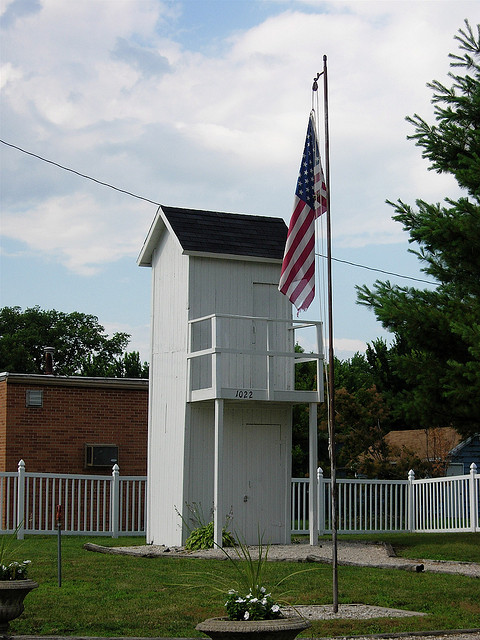
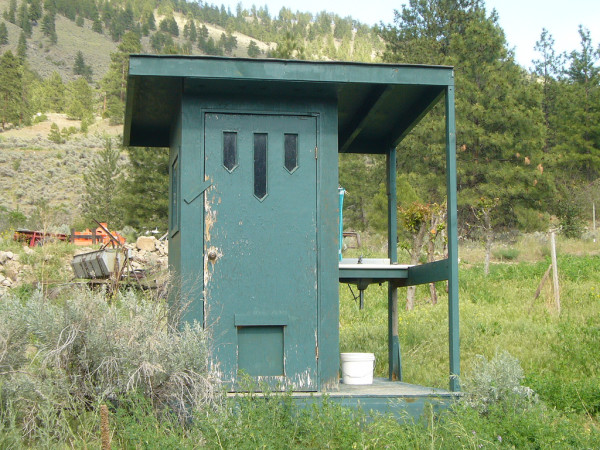
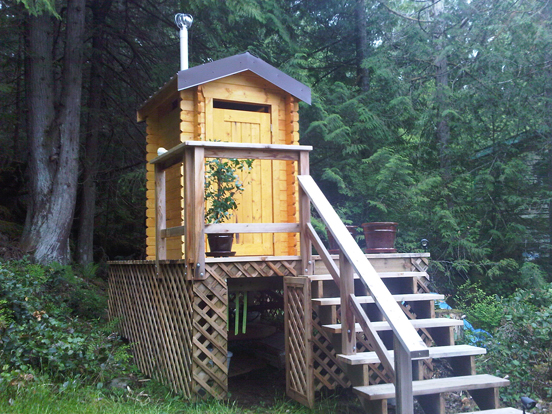
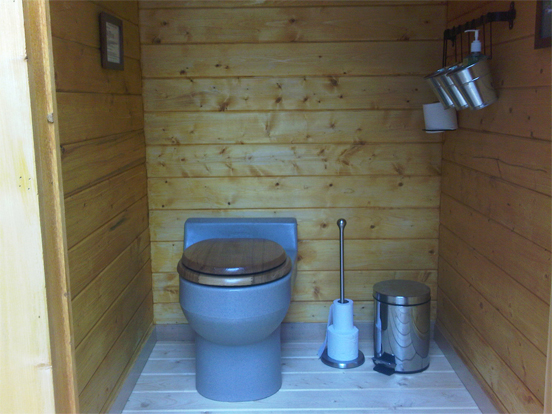

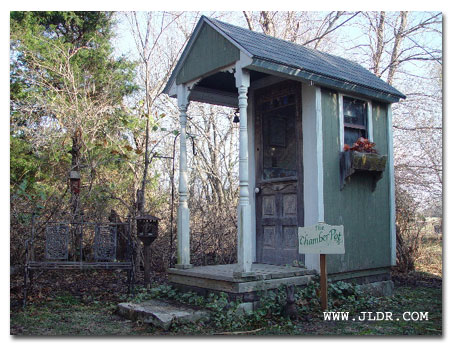

Outhouses have come a long way since they first started 500 years ago. The tiny structures can now be modernized with electricity, heat, insulation, pumped water, a sink and even a shower or tub. Outhouses are also being integrated with composting toilets that are vented and even run on solar.
If you’re interested in having an outhouse for your tiny house, Mother Earth News has several articles on how to build an outhouse, sanitation issues, beautifying your outhouse and how to stay warm while visiting your outhouse in the winter. There are also several books available including the Vanishing American Outhouse by Ronald Barlow and the beautifully photographed Nature Calls: The History, Lore and Charm of Outhouses by Dottie Booth.
Photos courtesy of thedailyenglishshow, Gravitywave, FrozenCapybara, jldr.com
By Christina Nellemann for the [Tiny House Blog]


If we all used modern, sanitary outhouses maybe our water supply wouldn’t be teeming with prescription drugs and antibiotics.
All hail the thunder bucket!
Brian, that would be great…unfortunately the laws/zoning requirements that have been enacted to prevent human composting and outhouse usage have been forced upon us due to those who are too lazy to maintain such a facility. Not to mention it is not in the best interests of real estate developers or local governments…they ALL want their money!
Yes, it would be great if “everyone” did this, but society is full of lazy, self-serving and inconsiderate people who prefer to drink tap water that has been used to flush waste, drugs, chemicals and all sorts of toxins.
It really is no wonder we lead the world in cancer rates…oh well
Yeah, geez. I just read Uniform Plumbing Code for greywater systems. A ‘legal’ greywater system is similar in complexity and cost to a small septic system. Read: $6000-$8000 or more!
The area of WA i live in still does not allow any greywater systems. Some commercially made composting toilets are allowed.
If composting and greywater are used with care (and regard to surface runoff, which depends on your soil, etc) they can be perfectly safe. And a whole lot cheaper than running EVERYTHING though the local sewage treatment facility.
I’m ready for some sort of revoLOOtion here…
Drives me crazy that the use of a composting toilet doesn’t remove the septic system requirement in most jurisdictions. My neighbour had to pay $25,000 for a septic system because he wanted minimal disturbance of his heavily forested hilly property. There is a spring fed pond at the bottom of the hill on the farm below my place so I have to be especially careful about composting. There are (barely)underground streams running through my property that lead to the pond as well so you have to be careful about that too. It can be a pretty complex situation to use outhouses properly, depending on geology, population density and hydrology.
I can echo that. We are soon moving to a large farm where there is a seasonal swale cutting right through the middle, and a wetland at one end. In the wet season, surface runoff is quick and comes from all corners of the peice of land.
We have to do ‘contained’ composting for the loos. This is where toilet waste goes into a closed worm bin for almost a year before being ‘turned out.’
Similarly, greywater has to be carefully contained, though only the tiny house is producing any. It has 1 bathtub and 1 kitchen sink (both used by 1 person.)
To say that the outhouse originated in Europe sounds false to me.
Because Europeans didn’t go to the bathroom 500 years ago. They just swelled up and hopped boats for the new world.
Given the sun/moon and European’s original Pagan roots, it fits. The Vikings brought the saunas so somehow to me, a simple outhouse seems plausible.
When I was a child, my family had an outhouse. It never had a bad odor. The trick to preventing odor is to get fresh sawdust from a sawmill. Keep it in a plastic container so it doesn’t dry out. After you take care of your business in the outhouse, drop a couple big scoops of sawdust into the hole. The sawdust also adds more organic material to help with decomposition.
I also grew up with an outhouse (no running water in our house until I was 10) and I *still* have an outhouse (but now indoor plumbing as well). Luckily, I live in a fairly rural area that still allows them. To keep the smell down, we always used lime. The garden needs it every year so what’s an extra bag or two for the outhouse. Mine is pretty rustic but, wow, some of these are little beauties. Now I’m thinking about upgrading!
If you don’t live near a saw mill, where can one get the sawdust? Make your own? Sounds pretty expensive.
Yeah! I love to see this topic come home. It usually takes the #2 place in popular discussion…
I just had the opportunity to use some large (12 seat?) pit toilets at the Oregon Country Fair. They smelled, well…. fair, but not wonderful.
Composting privys rarely smell bad with the apropo amount of sawdust. I’ve been building the 5 gallon bucket version of these for years and love them dearly… so much that it is getting really uninspiring to ‘flush’ when I have to.
Three cheers for #2 and the loo,
Abel Zyl
A great/fun book on the subject is “Nature Calls” by Dotty Booth (strangely similar to “Potty Booth”- but I guess its here real name!)- there’s a outhouse society and museum that she’s involved with in Halifax, NS too…..
I had a write-up on the book here in my “Ten of The World’s Most Bizarre Outhouses” post a ways back. Dotty’s book, used, is now going for $0.02 on Amazon! Crazy…
http://relaxshacks.blogspot.com/2011/08/bizarre-n-funky-and-skunky-outhouses-3.html
-Deek
oops- didn’t see that you mentioned that one, I own the Barlow book as well- its a good one….I also own an outhouse- I built one for my Vermont cabin/camp- its clad in corrugated metal and has been dubbed “The Bomb Shelter” as a result….it works GREAT- been there, same hole, for 12 years now….
Another book is Outhouses of the East http://www.amazon.com/Outhouses-East-Ray-Guy/dp/0920852033/ref=cm_cr_pr_pb_t with photos by Sherman Hines.
This makes me recall stories my Mother (God Bless her, we miss her) used to tell us, about growing up a sharecropper’s daughter in Lafayette, Alabama, where their 100 year old two-room ‘shack’ was pretty much the same from when she was born (1927) to when she married and moved out (1953): no indoor plumbing, and electricity was provided by a network of cords and extension cables tacked to the plain-wood walls (run from the power pole shared by two other sharecropper families)…
Her father continued to farm the 40 acres of cotton and sorghum until he suffered and died from a heat-stroke, in 1959.
The outhouse ‘outback’ was something Mom used to describe to us kids in great detail, down to the well-read Sear Roebucks catalogs that were used as… well, let’s just say most poor folk during the Depression used whatever was at hand in lieu of the more ‘extravagant’ and expensive toilet paper.
Mom used to tell us that when she and Dad married and moved into a new trailer (in a little court called ‘Sea Sands Trailer Park’, just off the Keesler AFB they moved to when Dad was transferred), that she almost didn’t know how to ‘use’ the indoor toilet (FLUSHING was a whole new thing to her, something she’d only experienced two or three times, growing up, when visiting a ‘better-off’ relative in Tallapaloosa or using the bathroom at the hospital when her mother fell ill – even the schools she’d attended back then had outhouses!), and Dad used to embarass Mom when he’d joke that he’d had to ‘teach her’ how to flush a toilet…
So Mom was forever grateful for the indoor bathrooms we kids took for granted…
Now, we come full-circle, and, as adults in a completey newer generation, are pining for off-the-grid homes, compost toilets, even outhouses! 😉
I can’t help but wonder what my dear Mom would think of this… movement.
LOL…. 😉
jipsi, I love this story.
Yes. Thank you for telling us this story, Jipsi. Very heart warming.
Sears Roebuck going with glossy pages was a sad development. But they still got used. 😀
I know. A guess people just didn’t ‘take a shine’ to them as much….
lol
Just to throw a related topic into the pot (yes, that was on purpose)some people use cloth wipes instead of T.P. If you search for “family cloth” you’ll come up with a lot of results. Some of you may already use these, some will be disgusted, others may be intrigued. The cheapest and easiest to make are just cut up t-shirts – heavily ribbed ones tend to resist curling up better. No hemming required. An easy way to wash them if you aren’t currently using cloth diapers seems to be a commmon problem. One solution is to do a prewash in very hot, soapy (possibly bleachy) water then toss them in with your regular laundry.
That would be a hand prewash – gloves optional!
Ah, the last time I came upon an outhouse, there was a dead dog in the bottom of the pit. There was a area on one side of the outhouse where a small animal could easily could crawl through, & that’s probably what happened to the dog. Thinking of how much the poor dog must have tried in vain to climb out, and the suffered he must have gone through before finally dying, turned me off the quaintness of having an outhouse.
Oh, Jayson… that makes me soo sad (being a VERY sensitive animal-lover). ;-(
See, I’m the kind of person that frets for weeks over a bird that crashed into my side mirror (as I’m driving down the highway at 60mph)… and when ANimal Planet aired the “Meerkat Manor” episodes where, first, FLOWER (the matriarch of the ‘starring’ clan of cute little critters (yes, wild animals, but hard to remember this when theyve personalized them by focusing on their idiosyncracies and giving them NAMES and a ‘story’!) went after a Cobra that had burrowed into her nest to get at her babies, and, of course, she was bit, and the cameras kept rolling on her as she lay dieing beside the burrow, after crawling out and succumbing to the bite… I cried, why didn’t the photographers/handlers DO SOMETHING, like chase the Cobra out of the burrow BEFORE the mama meerkat ambled home after a day of hunting? To keep it ‘natural’, they defended themselves, later.
Sorry. Natural gets thrown out the window when you’ve invested 2 years and tons of time and money filming these animals, many since their own births, and luring the public (viewers) into ‘getting to know and love them’ – not just the children were outraged and appalled, so were the adults of us that had made the show a regular Sunday night event with our kids (or not)!
Anyway. Four episodes later, another favorite had FINALLY found ‘happiness’ and acceptance from being a lonely loner, happily romping with a new friend/mate one moonlit night and the next morning found her new friend looking for her… and finally finding her lifeless, Coyote-savaged little body outside her burrow (that one was Mozart, a prominent ‘daughter’ of Flower’s).
ANYWAY. I KNOW this has nothing to do with outhouses.
But Jayson’s post brought up something that IS relevant, I suppose, and this was the lynchpin of MY response, I guess: some of us are too doggone sensitive/squeamish for our own good, and going rustic will never be as easy for some of us as it might be for others…
For instance, I go BERSERK on just SEEING a cockroach, and if it’s INDOORS, I’m flipping out and doing all but calling the national guard in… another subject for another day, of course (bugs, and the bug phobic among us who haven’t gone camping in years BECAUSE of it).
Living tiny would have to require living ULTRA-NEAT (and clean), so minimizing furniture (already a monumental task due to the size limitations of a tiny house) would be NECESSARY for some of us.
A tangent-aside: Can these little structures (tinies AND the complent outhouse) be built with some kind of INSECT REPELLANT (natural/homeopathic is okay, IF IT WORKS) already in place between the walls, to prevent unwanted intruders?
The thought of sitting for a spell in such a private place, only to witness …. a large bug… crossing your toes (or worse, already waiting for you, beside the ‘seat’) gives me the willies NOW just talking about it… lol
As far as natural insect repellant goes, that would be: cedar. There are a couple others, but cedar is the most available, lightweight, etc.
Also, building technique will determine if insects and rodents will be able to enter a structure. All it take is a little care, and easily available things (like screened vents for example) and you can stay bugless for many years.
…Except for the ones you let in through your front door. I like the garden spiders who live in the outhouse! They are charming and they eat the other bugs that wander in.
Jipsi, I stopped watching the Meerkats after they allowed that cobra to kill Flower. Maybe “natural” is their defense but I’m more inclined to think they got off on watching something suffering to death and die thinking it would get them better ratings. We are supposed to leave things better off than we found them; not worse.
I’m glad the subject of bugs came up. When I finished my vardo and brought it back from Canada it was full of earwigs because the it was constructed in a cow barn. I’m in the planning stages of my tiny house and CEDAR is going to be a construction material. I may put corrugated steel over it; not sure just yet. And I just made a note to screen my vents. So glad you brought this up!
I didn’t know about various states having composting and grey water laws. Too bad TH doesn’t have a section where people can bullet list the codes and problems one will face in each state; this would be great time and energy saving information.
A subject near and dear to my heart, my folks still use an outhouse at their summer place, its gotten fancier over the years, but still gets regular use as the only loo onsite (no matter how much my sisters hate it!)
Fun post! Here at our little summer cabin in Sweden, our toilet is located in the garage…it’s a toilet where the urine goes in one bucket while the rest goes into another for composting….we dilute the urine with water and spread around our grounds here and it makes everything grow nicely. The other waste is left in a bucket for a year mixed with some soil and by the next season is broken down quite nicely and added to our compost bin….thankfully it’s my husbands job to dispense of the waste products…grin. The door to our little toliet comes from my husbands father’s fathers house here in Karlstad, Sweden. I’ll have to take a photo of it for you all to see. 🙂
That is so well planned. I would love to see your photo.
This past winter we had a bad ice storm here in Oly WA. Our power was out for about a week, and with the new septic system we were forced to install last summer, we weren’t sure if we could do the ‘gravity flush’ that we used to. So my husband put a 5-gal bucket (he’s a house painter, so they’re readily available around our place) and a bag of sawdust in the bathroom. It wasn’t very comfortable, but did the trick, and wasn’t so bad under the circumstances. But our sixteen-year-old daughter cried and complained every time she had to go. This girl was born in a plumbingless village in China, was trained to use a hole in the ground by the age of ten months, and thinks it’s strange to change her underwear every day, but proclaimed our makeshift ‘outhouse’ to be ‘gross and inhuman!’
🙂
Very cool article and comments. We had no indoor plumbing till I was about 8 years old but had a great three-holer outhouse. Can’t remember dad ever needing to call a plumber to fix it or buying taxable water to support a rural water system. The Sears and Montgomery Ward catalogue always played a big part in the business. I am always amazed that people are willing to spend $30,000 or more on a little room in the house so they can just flip the little lever on a porcelan chair to get rid of their human waste.
Like Tim, we had no indoor plumbing until I was 7 and we had a 2-holer. I remember every Halloween all the outhouses in the area would get the customary “tipping” treatment. It was always a family affair the next morning to right the building before the morning usage. Aaahh, the good old days! I hope that tradition is long gone as we just finished building a composting toilet outhouse at the lake.
Years ago I read about a homesteader in Maine. He said land was cheap (relative term) if it had no water. He built a home with plenty of water catchment for every use EXCEPT waste management. He then went into a long dissertation about how to built a MODERN outhouse or privy. It was written up in Mother Earth News, but every time I try to research it, I can’t find it even though I tried all the usual phrases including modern outhouse, privy, homestead, Maine etc. If anyone with better research skills than I could find this, it would make a very useful addition to this post and I would be most appreciative to see if his “science” still holds up.
One way to keep the pit covered and keep the smells in is a rotating drum under the seat, above the pit.
Under the seat is a half-drum, like a bowl, to catch the waste as you sit. After you’ve had your consitutional (or constipational, as the case may be), you close the seat lid and rotate a handle, causing the drum to turn and its contents to fall in.
The drum seals off the pit and keeps the smell in and flies out. It also would have the benefit of catching your keys or cell phone if they happened to fall in. You wouldn’t have to reach as deep, or into as much filth, to recover them.
A little ditty from my childhood:
In days of old
When knights were bold,
and toilet bowls weren’t invented,
I laid my load upon the road and
walked away, contented..:)
I would really like to get some plans to the out house that is the 6th picture down and says there are vintage ouhouses on ebay. Please let me know where I can find some. Thanks!